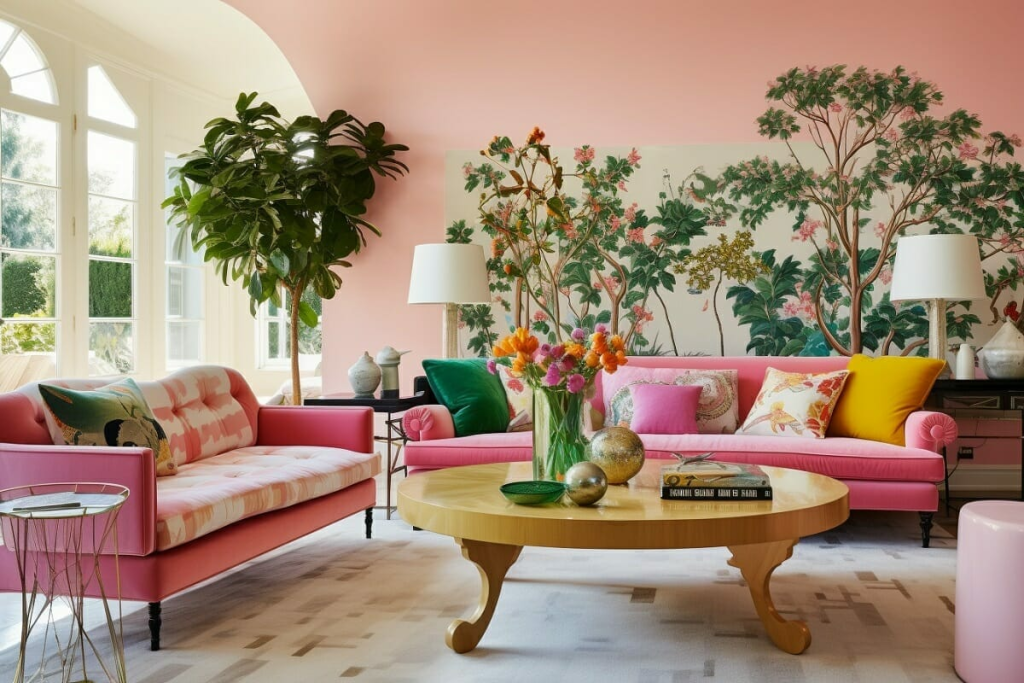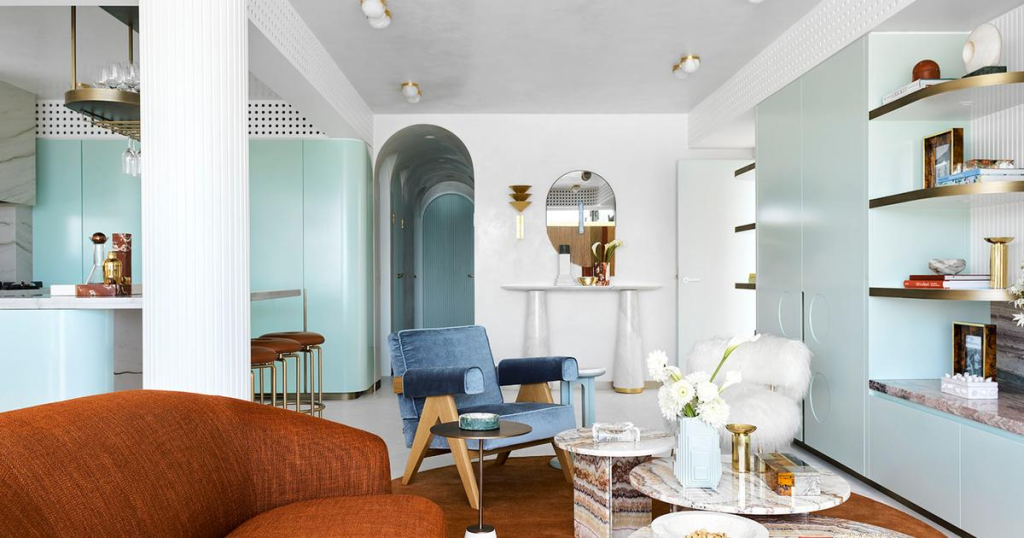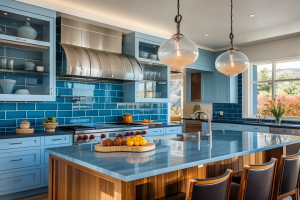As we approach 2024, it’s time to take a fresh look at interior design trends. After the uncertainties of the past few years, our homes have become a sanctuary, and their design has become a priority. In this article, we will explore the emerging trends that will shape the interior design landscape in 2024 and beyond. From texture and color to materials and lighting, there’s something for everyone to embrace and incorporate into their homes.
Texture Takes Center Stage
Glossy, high-gloss walls are out, and texture is in. While plain white walls are still not in vogue, the focus is on finishes that add depth and character to a space. Interior designers are moving away from smooth, reflective surfaces and embracing textured finishes such as hand-applied plaster, Roman clay, and limewash. These finishes create a tactile experience and bring a sense of warmth and interest to a room.
Los Angeles designer Oliver Furth highlights the importance of texture in design, stating that “straight painted sheetrock doesn’t feel exciting right now.” Instead, designers are exploring three-dimensional patterns in wood and stone. Patterns created by manipulating natural materials add visual interest and change with the play of light, creating a dynamic and engaging atmosphere.

Embracing Earthy Browns
In 2024, we can expect to see a resurgence of brown as a statement color. Designers are incorporating warm, rich browns reminiscent of the 1970s palette into their projects. Shades of brown, including chocolate, caramel, and persimmon, are making a comeback, adding depth and warmth to interior spaces.
Dallas-based interior designer Jean Liu notes the rising popularity of brown, particularly the “Billy Baldwin variety of brown.” According to furniture marketplace 1stDibs, dark brown was one of the top three colors predicted to be popular in the coming year. Light brown and shades of yellow also made the list.
Brown is a versatile color that serves as an excellent neutral base for layering with other colors. New York interior designer Alyssa Kapito describes the shift from gray to warmer tones like sepia and caramel, stating that “everything was very gray, and now it’s much warmer.”
The Rise of Terra-Cotta Tiles
Terra-cotta tiles are poised for a takeover in 2024. Designers are embracing the sculptural opportunities and natural shades offered by these clay-based tiles. The versatility of terra-cotta allows it to seamlessly fit into various design styles, from Italianate to Spanish, Art Deco to Arts and Crafts.
Architectural designer Tom Kligerman expresses his appreciation for terra-cotta, highlighting its potential for creating geometric textures and sculptural effects. He mentions exploring different colors, including beautiful greens and cobalt blues, to add visual interest to spaces.
Los Angeles designer Oliver Furth shares his enthusiasm for terra-cotta tiles, stating that he is currently working on a bathroom design inspired by the style of artist Georgia O’Keefe. The star-shaped terra-cotta tiles he plans to use will create a stunning visual effect reminiscent of a luxurious hamam.

The Enduring Appeal of Bouclé
Bouclé, a nubby-textured fabric, has stood the test of time in the world of interior design. From Eero Saarinen’s iconic Womb chair to Chanel suits, bouclé exudes a sense of opulence and luxury. In 2024, we can expect to see bouclé continue to make its mark in interior design.
San Francisco-based interior designer Nicole Hollis describes bouclé as the epitome of quiet luxury. While it may not be suitable for an entire apartment, it adds beautiful texture to a room when used selectively. Bouclé chairs, sofas, and accessories will continue to be sought-after pieces in interior design.
Designer Alyssa Kapito emphasizes the importance of balance when using bouclé in a space. She suggests mixing bouclé pieces with items featuring straight lines to create an interesting and harmonious composition. The timeless appeal of bouclé lies in its ability to add texture and depth to a room without overpowering it.
Curves Meet Straight Lines
In 2024, expect to see a departure from straight lines and a celebration of curves and softer shapes in interior design. Scalloped details, undulating wood-carved elements, and curved furniture pieces are becoming increasingly popular among designers and their clients.
Interior designer Jean Liu notes the growing popularity of scalloped details in furniture design, whether in the frame of a mirror or as an upholstery detail. These curved elements add a touch of whimsy and visual interest to a space.
New York interior designer Alyssa Kapito emphasizes the importance of mixing curves with straight lines to create a balanced and visually engaging room. She suggests having a combination of curved and straight furniture pieces to create a dynamic and interesting composition.
The Appeal of Artisanal Craftsmanship
In the post-pandemic era, there’s a renewed appreciation for the artist’s hand and the human touch in design. Handmade, one-of-a-kind pieces created by skilled artisans are highly valued and sought after. From hand-carved wood furniture to handblown glass and ceramic tiles, the irregularities and imperfections in these pieces add character and a sense of authenticity to a space.
Interior designer Oliver Furth highlights the soothing nature of human irregularity in design. Clients are seeking out handmade pieces that showcase the skill and artistry of the creators. The trend towards artisanal craftsmanship extends to various design categories, including upholstery, ceramics, jewelry, and decor.
New York and Palm Beach-based designer Victoria Hagan appreciates the character and uniqueness that handmade pieces bring to a space. She celebrates the imperfections found in these pieces, noting that “we’ve all certainly learned that life is not always perfect.”

The Power of High-Tech Lighting
Advancements in lighting technology have revolutionized the way we illuminate our homes. In 2024, high-tech lighting with color tuning capabilities will continue to gain popularity. Color tuning allows homeowners to adjust the intensity and color temperature of the light in a space, creating a desired ambiance and enhancing the display of artwork.
Interior designer Jean Liu highlights the practicality and transformative power of color-tunable lighting for art collectors. It elevates the way they interact with their art, allowing them to showcase it in the best possible light. Brands like Philips, AiSPiRE, and USAI Lighting offer a range of products that enhance interior LED lighting and provide color tuning capabilities.
Embracing Sustainable Materials
In the pursuit of a more sustainable future, interior designers are paying close attention to the materials they use. There’s a growing demand for furnishings and products that are environmentally friendly and sourced responsibly. Designers are exploring alternative materials and innovative production techniques to minimize the negative environmental impact of their designs.
San Francisco-based designer Nicole Hollis highlights the importance of materiality and sourcing. Designers are creating interesting and unique products by considering the origin and composition of materials. From furniture made from recycled cardboard to rugs blended with sustainable fibers like eucalyptus silk, designers are pushing the boundaries to create more eco-friendly designs.

The Revival of Victorian-Era Details
Victorian-era design elements are making a comeback in 2024. The aesthetics of 19th-century design, with their ornate moldings and moody palettes, are gaining popularity once again. However, designers are putting a modern twist on these traditional elements, creating a balance between ornate and contemporary design.
Architectural designer Tom Kligerman cites the influence of late 19th-century Parisian style on current design trends. Crown moldings, chevron floors, and intricate millwork are finding their way back into interior design. However, these elements are being reinterpreted in a more abstract and rectilinear manner, removing some of the fussy and floral details associated with the era.
Chairish president Anna Brockway attributes the rise of Victorian-inspired flourishes to a broader maximalist trend. The layering of furniture, art, and decor with Victorian-inspired elements creates a unique and one-of-a-kind look.
Conclusion
As we look ahead to 2024, the interior design landscape is filled with exciting trends to explore. From the texture and warmth of brown tones to the sculptural possibilities of terra-cotta tiles, there are endless opportunities to create unique and inviting spaces. Embracing artisanal craftsmanship, incorporating high-tech lighting, and choosing sustainable materials will ensure that our homes reflect our values and provide a sense of comfort and beauty. Whether you’re drawn to the curves and soft shapes or the revival of Victorian-era details, there’s a trend to suit every taste and style. So, embrace these trends and transform your home into a haven of style and creativity.




No comments! Be the first commenter?